
The great changes that took place in the realm of artillery in course of the First World War wrought a corresponding change in nomenclature. Many new terms came into circulation and, at the same time, existing terms were put to new uses. To further complicate matters, the new terminology introduced during the war has remained relatively stable for the better part of a century. For example, the introduction of artillery pieces that could be employed as both guns and howitzers (“gun-howitzers”) led to a situation where terms that had once described two very different sorts of artillery pieces became synonyms, not merely for each other, but for “artillery piece” itself. Likewise, the eclipse of the shrapnel shell by the high-explosive projectile deprived the word “shrapnel” of its highly specific meaning, converting it from the name of a particular type of projectile into a generic term that covered any fragment created by an explosion of any kind.
Where changes in nomenclature were concerned, what was true for nouns was also true for adjectives. Before 1914, the term “field” (as in “field gun” or “field howitzer”) applied to a portion of those artillery pieces that, when pulled by reasonable numbers of reasonably-sized horses, were mobile enough to accompany armies on campaign. After 1918, the realm of “field artillery” covered all of those artillery pieces (save those optimized for firing at aircraft or tanks) that could be moved without the use of extraordinary measures. Before 1914, field artillery pieces were often divided into the categories of “light” and “heavy.” After 1918, the old categories had shifted somewhat, both to accommodate the new weapons on either end of the spectrum and to make room for the new category of “medium.”
Perhaps the greatest change in artillery terminology concerned the words and phrases related to mechanisms designed to manage the recoil forces generated by firing. Before 1914, when the artillery parks of the world were full of guns and howitzers that lacked integrated recoil systems, it was necessary to specify whether these devices were integrated (“on-carriage”) or attached (“off-carriage”). After 1918, most artillery pieces without integrated recoil systems were relegated to museums. Thus, when one referred to a “recoil system” all concerned could safely assume that it was part of the mechanism that connected the piece to the carriage rather than a device that connected the carriage to a platform of some sort.




